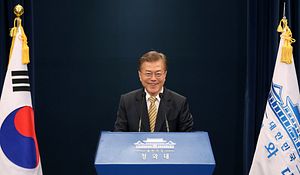Earlier this year, the world eagerly anticipated what was once a rare event: an inter-Korean summit.
Following just two previous meetings – involving former North Korean leader Kim Jong-il and progressive South Korean presidents Kim Dae-jung and Roh Moo-hyun, in 2000 and 2007 respectively – current President Moon Jae-in met Kim’s son, Kim Jong-un, on April 27 at the Panmunjom Truce Village.
The meeting was the first inter-Korean summit outside Pyongyang and supercharged Moon’s domestic popularity. It represented the culmination of three months of intense diplomacy, following Kim’s New Year’s Day change of heart on January 1.
After more than 40 ballistic missile tests and three nuclear tests between 2016 and 2017, Kim had declared his nuclear deterrent force complete and opened up to the world, pursuing talks not only with Moon, but with President Xi Jinping and, eventually, U.S. President Donald Trump.
While much of the world – certainly the United States – has zeroed in on the issue of denuclearization, there is the obvious matter that the inter-Korean diplomatic process is about much more than just the final status of North Korea’s nuclear weapons and ballistic missiles.
Just one section of the Panmunjom declaration, agreed to by Kim and Moon, deals with the matter of the peninsula’s “complete denuclearization”.
The rest of the agreement focuses on improving the valence of the inter-Korean relationship and setting the conditions for an enduring peace between Seoul and Pyongyang, who technically have remained at war since the signing of the 1953 Korean war armistice.
But the fifth inter-Korean summit – scheduled for September – might not be as easy for Moon as his first two meetings with Kim this year. Four factors make this likely.
First, while the April sit-down was marked by positive interaction between the two leaders and Moon sharing his plans with Kim for North Korea’s economic transformation, the bill may come up at the upcoming meeting.
In the intervening months, North Korea has reverted to its traditional calls for sanctions relief, backing up its position by pointing to several “denuclearization steps” it has taken, including its self-imposed moratorium on testing intercontinental-range ballistic missiles and nuclear weapons.
South Korea has made a great effort to press on with every kind of inter-Korean activity under the sun not prohibited by UN Security Council sanctions.
After 2017, the sanctions against North Korea have grown so pervasive that the scope for inter-Korean economic activity is effectively nil.
Moon will not be able to promise Kim any concrete economic measures – not without the backing of the Security Council’s veto-wielding five permanent members, also known as the P5 (namely China, France, Russia, Britain and the U.S.).
Second, the summer has been filled with reports of ongoing North Korean ballistic missile and nuclear material production activity.
This is not an example of Kim’s duplicity. When he signed on to an agreement promising “complete denuclearization” in Panmunjom and again in Singapore with Trump, he did not mean unilaterally disarming. Instead, Kim has pressed on with what he outlined during his New Year’s Day speech.
For Moon, there will be pressure from the U.S. to follow through in encouraging Kim to take a concrete step toward what Washington would consider denuclearization. This will be difficult and will be seen negatively by North Korea if framed in the terms that U.S. Secretary of State Mike Pompeo, for instance, used recently.
Third, the upcoming inter-Korean summit will see a heavy North Korean emphasis on a push to declare the end of the Korean war – a prerequisite to move the peninsula towards a “peace regime,” as required by the Panmunjom declaration.
Seoul supports this objective, but Moon cannot promise Kim that he’ll be able to bring the U.S. along.
Finally, the upcoming inter-Korean summit will also take place against a backdrop of sliding domestic approval ratings for the Moon administration. Gone are the days of sky-high approval in the days and weeks following the Panmunjom declaration.
If the fifth inter-Korean summit does turn out to be more of a challenge than the preceding Moon-Kim encounter this year, South Korean faith in the administration may recede, if not the sense of optimism about peace on the peninsula, more broadly.
Moon and Kim may surprise the world in September.
For instance, we may see Moon secure an agreement from Kim to travel to New York to attend the United Nations General Assembly’s general debate, opening up the possibility of a second encounter between the North Korean leader and Trump.
This development would be in North Korea’s interest, given the recent emphasis in official state media on the Kim-Trump relationship.
Whatever waits ahead, the fifth inter-Korean summit will have deep implications for the trajectory of this year’s remarkable and sudden turn toward diplomatic engagement with North Korea.
For Moon Jae-in’s peace project, everything will be at stake.
This article first appeared at the South China Morning Post. It is republished here with kind permission.

































